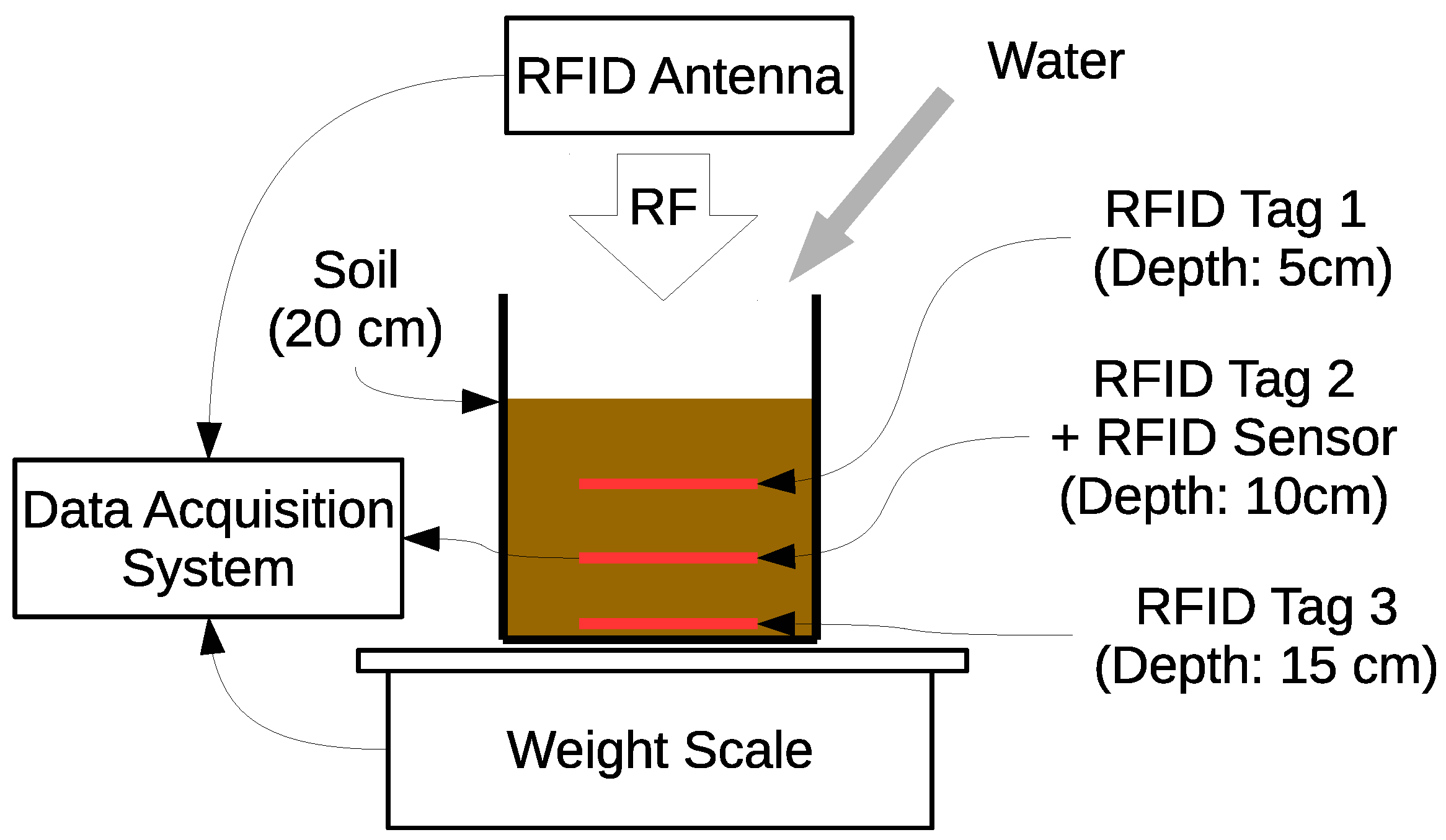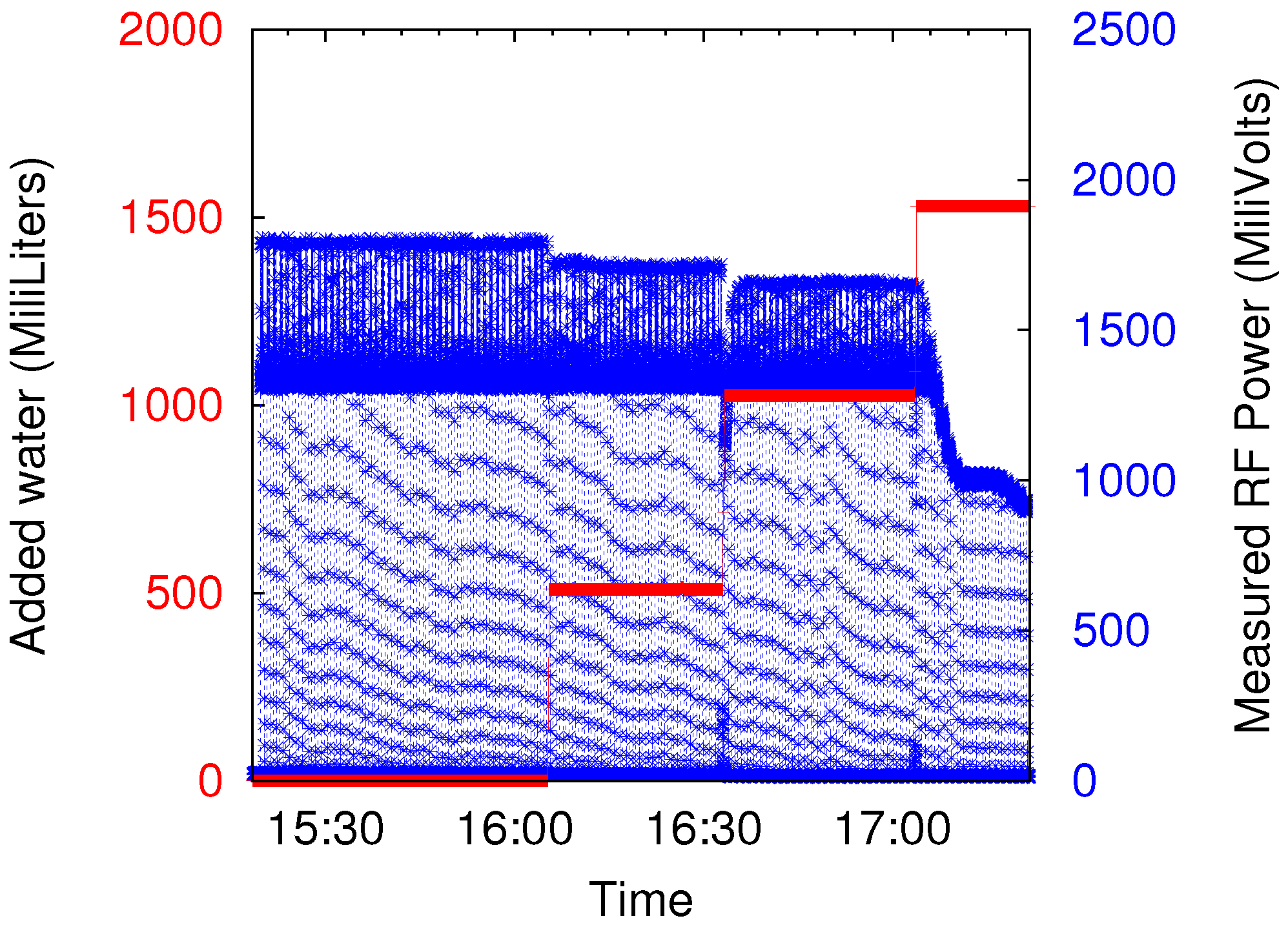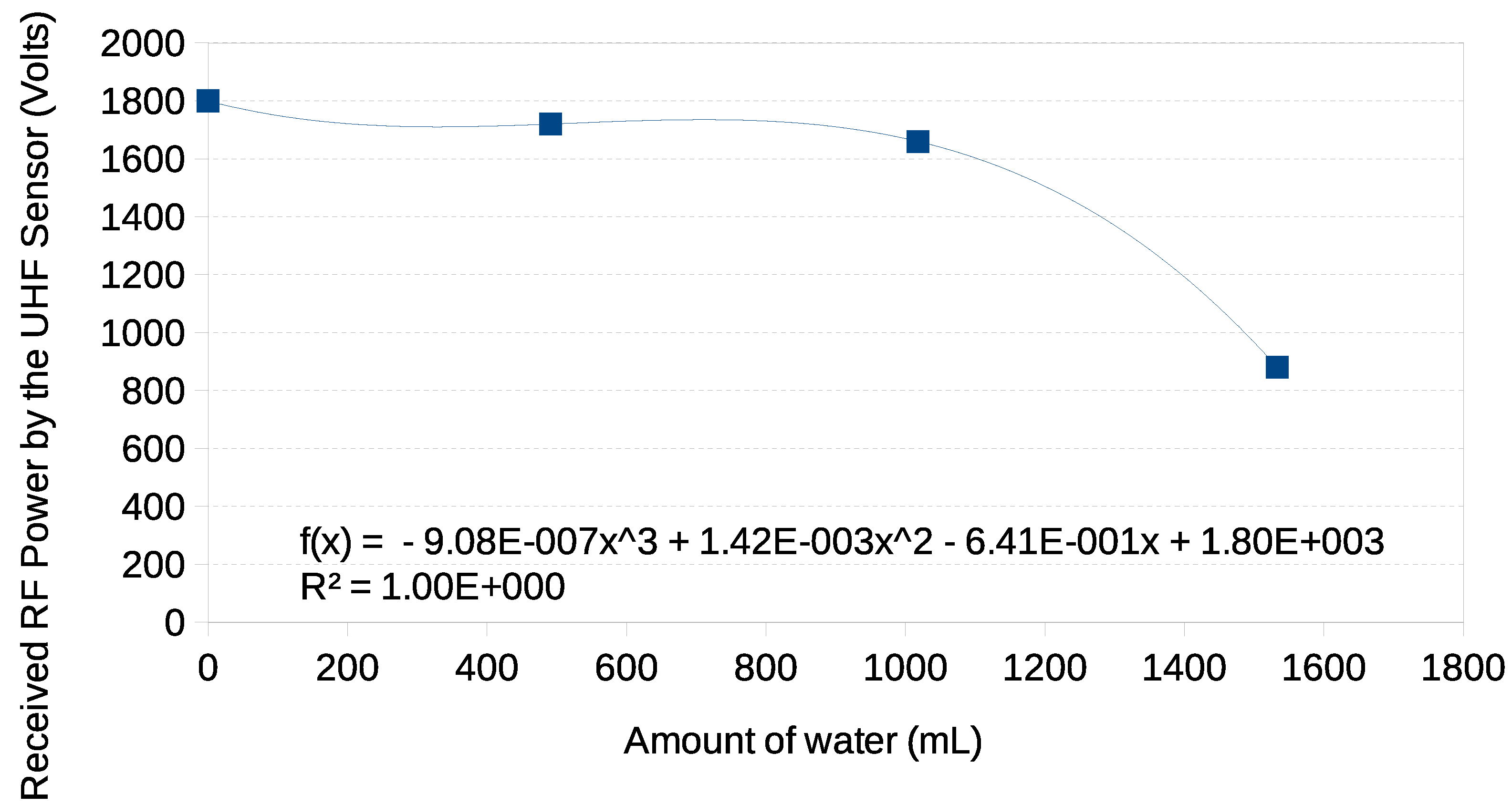1. Introduction
One of the most important concerns during plant development cycle is the proper application of irrigation. Whether for agricultural production of fruits, vegetables and grains or even for flowers and ornamental plants, irrigation plays a key role in supplying water to meet crop requirements. However, to meet product development needs, irrigation demands a lot of water: it is known that up to 80% of all the freshwater of the world is used for agriculture [
1]. This considerable use of water can have significant impacts on the environment and conflicts with current issues of providing water to the population, a topic that is even more relevant due to frequent water supply crisis and rationing risks in several parts of the world.
One common form of irrigation control is timer controlled, where a timer is used to turn irrigation on and off following a programmable schedule. It is known, however, that these systems generally provide an inadequate amount of water, which can cause various problems to the soil, to plants and to the environment. Excessive water, for example, can cause diseases due to lack of oxygen in the root of the plant, while water shortage can reduce the plant’s growth and productivity.
In that way, recent researches [
2,
3] present technological challenges for better precision agriculture and soil monitoring systems. One of the presented challenges is the need of new sensor systems with simplified installation and use that could be completely buried, preferably without wires, to prevent animals from masticating the sensors or even people and animals from stumbling on them. These researches also argue that people or farm machinery could damage the sensors.
One emerging technology that is starting to be used for agricultural sensors is the Radio Frequency Identification (RFID) technology. Passive RFID tags harvest energy to power its circuits only from the received antenna radio signal. It is common to find passive tags in the form of adhesive labels of paper and costing a few cents. One recent research trend is the use of RFID tags as sensors of several types, which are called Sensor Tags [
4,
5]. This work explores the feasibility of using standard passive 900 MHz EPC/GEN2 tags as a sensor tag to measure soil moisture.
2. Related Works
The need for new practical soil moisture measurement systems led to the development of several solutions. Pratt et al. [
6] present a system based on a transmitting antenna positioned at a certain known angle that emits a radio signal with a frequency of 2.4 GHz towards the soil, and another (receiving) antenna, positioned at an angle and height previously established with 3 meters distance from the transmitting antenna. The receiving antenna captures signal dispersed by the soil and a computer system analyzes the differences between the emitted and reflected signals, determining the state of soil moisture.
For house or garden potted plants water stress monitoring, a possible setup consists in the use of several conventional EPC/GEN2 tags glued in the internal part of the wall of the vase [
7] allowing the measurement of the water level in this vessel or container. The tags are positioned along an inner side of the container and when the container is dry, all tags respond to the reader with their unique EPC codes. Knowing that water interferes with microwave radio signals, authors argue that when water completely surrounds one of the tags, such tag will no longer respond to the reader requests. Knowing the position of each tag in the container, it is then possible to know the level of water contained in that vase, however it should be noted that the system does not measure soil moisture itself, but only water level in a container. Hasan et al. [
8] describe the use of a single adapted EPC/GEN2 RFID tag to measure soil moisture on the field. The proposed setup involves the installation of a RFID tag on the soil surface, and a metallic conductor is connected in parallel to the tag antenna, which is inserted into the soil, so that the interference of the soil moisture in the tag’s antenna response is used to estimate soil moisture.
Another approach using an auxiliary sensor consists of using commercial sensor tag ICs to harvest energy from the RF signal, power sensors and digitally report read values from the sensor tag IC input ports to the reader using EPC/GEN2 custom commands. One solution that uses this method was first introduced around 2013, with an updated version presented in 2015, and is currently marketed by the Spanish company Farsens [
9]. The company developed a soil moisture sensor called Hydro [
9], which enables remote soil moisture measurements without battery and cables at distances of up to 1.5 meters. Bauer-Reich et al. [
10] use the SL900A commercial sensor tag IC from AMS, showing the viability of using RFID for subsurface soil sensors, as proposed in this work. In the study done by Bauer-Reich et al. [
10], the sensor tag can be read at distances of up to 3.7 meters in free space and at distances of up to 0.5 meters when buried, depending on the soil moisture conditions, tag depth and distance.
There are already several RFID based soil moisture sensor solutions. However, there is still the need for systems with simpler installation, lower cost, and that reduces periodic maintenance. Thus, the present article discusses the feasibility of using standard, off-the shelf, EPC/GEN2 tags as soil moisture sensors buried at different soil depths, without the need of cables, batteries or other power sources. Redemske [
11] shows experimentally that such proposal is possible, with an experiment: he installed an UHF reader and a RFID (and a UHF probe also) tag between a fishtank and measured the signal (RSSI and voltage) while he added 37 cm of water in the fish tank with 1 cm increments. He found a clear relation between the water level in the tank and the measured RF signal.
3. Materials and Methods
The main feature of the proposed system is the usage of standard EPC/GEN2 RFID tags fully buried in technical soil depths for irrigation scheduling and soil moisture monitoring. According to previous works [
10,
12,
13,
14] the use of radio communication below the soil surface is considered a challenging task, since the signal propagation is attenuated by the variable soil water, as well as by possible variations in soil contents that might exist. Despite these difficulties, there are evidences indicating the feasibility of performing data communication from a device buried in soil [
15,
16,
17].
In a study about the propagation characteristics of 900 MHz signals below the soil surface for data communication, one of the conclusions is that the success and quality of communication at 900 MHz in the soil profile is inversely related to the amount of water in the soil [
18]. The authors have shown this attenuation as a difficulty for applications of wireless sensor networks, however, in the system herein proposed, this electromagnetic attenuation, is the fundamental physical basis for data acquisition. Soil moisture inferences rely on measuring the intensity and signal attenuation as a soil moisture related variable. Another important observation made by these authors is that communication is possible, even below 2 meters deep, but through a single "path". This means that the reading antenna in relation to the buried tag has to be aligned. Moreover, Miller et al. [
18], indicates a mathematical relationship between attenuation of a 900 MHz signal that propagates below ground and its relationship with the water content on the soil.
In order to validate the proposed system, an experimental setup was prepared to evaluate commercial RFID tag performance for soil moisture inference.
Figure 1 depicts the experimental setup used: one vase with 30 cm diameter and 37.5 cm height was filled with dry soil up to 20 cm. Three commercial RFID tags (model BJTW01) were buried at depths 5, 10 and 15 cm. At 10 cm depth, an additional UHF RFID Sensor from Telaeris was used to measure the amount of RF energy received at that depth.
To perform the tests, an AS3993 RADON reader from Austria Microsystems (AMS) was used jointly with a 7 dBi RFID patch antenna from Poynting (model PATCH-A0025) for 860 to 960 MHz frequencies with circular polarization. A C# program was developed to continuously log the RSSI signal of each tag and the number of times that each tag can be read per second. The system also collects the total vase weight, with 1 gram resolution, and RF power received by the Telaeris UHF RFID Sensor. The data is collected with 2 s intervals.
The vase is only opened in its top, so the water can only be provided by wetting the top soil profile. Moreover, weight variation is only caused by water addition or evaporation, as there is no other way in or out for the water.
4. Results and Discussion
The main planned experiment consisted on adding water to the vase in known amounts, and analysing the RF and RFID signal variation after known amounts of water is added. Before adding water to the vase, the vase was mounted on the top of the weighting system and the system was isolated for 15 days, to check if there was no creep on the load cell, making sure that the measurement is reliable.
A total amount of 1.5 liters of water was added during an interval of 2.5 hours, distributed in 500 mL parcels, each deployed with 30 minutes interval.
Figure 2 depicts raw data collected, showing the RF power changing while more water is added. A direct relation can be seen between the amount of added water (red line) and the signal strength (blue line).
Figure 3 depicts a third degree polynomial fit performed with the collected data, which, in the given range, yielded to a fit with correlation coefficient of 1.0. It must be noted that such data shown is provived by the readings of the Telaeris UHF RFID Sensor connected to a 12-bit Digital to Analog Converter. RFID tag attenuation, measured by the RSSI variation of each tag, and reading rate of each tag have also shown similar results.
Soil moisture reading can be accomplished by a stationary or a mobile manner, thus making possible to install the RFID reader antenna on a vehicle, on a robot, or even in an air vehicle, preferably unmanned for autonomous data collection.
In the proposed system, tags can be installed in several depths, which is important to monitor the most adequate points where the roots of plants obtain water and nutrients from the soil. Different cultures develop specific rooting depth profiles according to the soil and the applied cultural practices.
One concern that should be considered for successful tag reading is position and orientation of the reading antenna. In traditional RFID applications, RF side lobes help a given reader to read tags in several directions and orientations. However, side lobes are considerably attenuated on the presented system as they reach the soil surface as shown on
Figure 1, restricting the reading space to tags covered by the main lobe of the antenna, which in turn requires a better antenna positioning and alignment for each spot that has one or more tags. To address this problem, two solutions are possible: the first technique is to use a global positioning system (GPS) receiver to geographically reference each tag at the time of its installation, and through a database, assisting users or automated systems to precisely locate each tag and perform your reading. Hand held systems could be developed and integrated with Smartphone applications to guide users in the task of locating each sensor tag.
Another approach to help locate the tags consists in installing visual markers, such as stickers or other marks identifying the location of installation of each tag.
5. Conclusions
This article presents a study that shows the feasibility EPC/GEN2 tags as soil moisture sensors through the analysis of the tags RSSI and the rate of read of each tag. Due to a direct relation between soil moisture and microwave signal attenuation, the RSSI value for each tag computed by the RFID reader is used to estimate water content on the soil. This was specially shown by the data collected by the UHF sensor tag from Telaeris, which provided the voltage harvested from the RF signal.
Standard EPC/GEN2 tags are widespread and low cost, enabling their usage as soil moisture sensors when needed with simple installation. Any standard RFID reader compatible with the EPC/GEN2 standard can be used, so the proposed system can be used in a variety of situations, such as reading by autonomous robots, automated irrigation systems, or even Smartphones with RFID readers as accessories. One drawback of the proposed system is that the sensor tag positions must be previously known. This can be solved by registering GPS coordinates of each tag installation, or adding landmarks on the soil to identify buried tags that could be read by robots or users with hand held readers. On large agricultural setups, the reading system can also be attached to a tractor that automatically collects data as it passes by the field.






